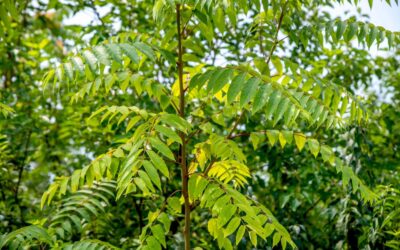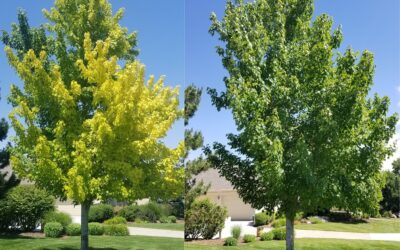If you want a beautiful, exotic shade tree that’s a living fossil too, you might want to look at the gingko. Unique among existing trees, the gingko is a species apart. It has no living relatives, all others having disappeared over its 270-million-year history.
Age and Native Range
Once widespread—fossilized remains have been found in both Europe and the Pacific Northwest—the only native stands are found in remote areas of China now. But the ginkgo’s unique foliage and adaptability led to its importation to Europe in the 18th century and North America in the 19th. Because of its status in Buddhism and Confucianism, it is widely planted in Korea and Japan and has naturalized some places there and elsewhere.
Characteristics
The ginkgo is large deciduous tree with unusual, fan-shaped 2-3-inch leaves. They are bright green during the summer and turn a brilliant gold in autumn. It grows in a pyramidal shape to 25-50 feet tall with a 25-35-foot span at maturity.
The ginkgo is deep-rooted tree, making it resistant to wind and snow damage. It’s adaptable to nearly all soils and tolerates both moderate drought and wetness. Pest and disease resistant, gingkoes prefer at least four hours of full sun a day.
They are remarkably hardy trees that grow well in USDA Zones 3-8, and tolerate air pollution and salty soils, making them popular as street trees even in dense urban areas like New York City and Tokyo. Some even withstood the nuclear explosion at Hiroshima in 1945 and still survive today. They’re also remarkably long-lived with a lifespan that can reach 3.000 years.
Female trees produce plum-shaped seed cones that can have very unpleasant aromas as they ripen after falling. This has led to the grafting of male trees on female root stocks to avoid the foul odors of the ripening seeds. Male trees, on the other hand, produce large amounts of pollen small cones that can aggravate some allergies.
The sees of ginkgoes are widely used in Asian cuisine and medicine, and ginkgo biloba leaf extracts are marketed as health supplements in the West, although their effectiveness has not been proven. Raw leaves can be mildly toxic when consumed, as can excessive amounts of seeds.
Varieties and Cultivars of Ginkgoes
While there is only one species of ginkgo, numerous cultivars are available in nurseries. Consult with nursery staff to choose one with the characteristics you want.
The Ginkgo as a Landscape Tree
It’s elegant fan-shaped leaves and sprawling branches make the ginkgo a striking addition to a landscape. In the summer, its bright green canopy makes it a great shade tree and its vibrant yellow-gold leaves put on quite a show in the fall. They’re quick to establish in almost any soil type and withstand pests and diseases extremely well.



